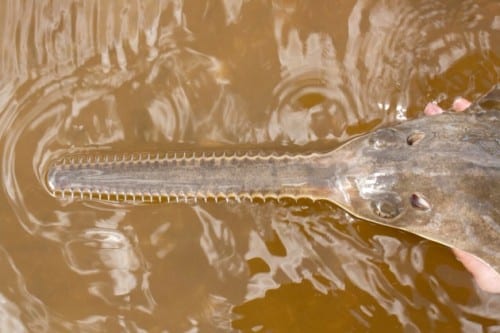Sawfish, cartilaginous fish that live mainly in shallow water in tropical days and in river estuaries can breed even without the need for two partners. So far this form of reproduction has been identified in a very limited number of vertebrates and this form of reproduction has never been observed in the wild.

So who needs males? For the first time, biological reproduction (parthenogenesis) was found in vertebrates in nature. Short-toothed pike (Pristis pectinata) usually reproduces sexually, but a recent study of a Florida estuary revealed that nearly 4% of individuals in a sample of this species are offspring of asexual reproduction. Sawfish, relatives of the sharks, are cartilaginous fish that live mainly in shallow waters in tropical days but also in river estuaries. Sawfish are so named after their serrated proboscis which they use for predation and protection. All sawfish species are in danger of extinction due to habitat loss and overfishing.
The ability to reproduce asexually in animals has been known for a long time, but it exists mainly in invertebrates, while in vertebrates there is very little evidence and most of them are from captive conditions and have not been observed in wild populations so far. According to the assessment, in small endangered populations there is a greater chance of finding asexual reproduction due to the difficulty in finding a partner. In asexual reproduction, the offspring are genetically identical to the parent, which may be a disadvantage in a changing and unstable environment. Sexual reproduction, on the other hand, allows for genetic variation and increases the chance that any of the offspring will survive in changing environmental conditions.
Nicholas Dolby, a marine ecologist at Simon Fraser University in Canada, said the findings add to evidence that cartilaginous fish have the greatest range of options for reproductive methods, more than any other group of vertebrates. "This is another incredible reason why we should be concerned about the fate of these species." added Dolvey, who serves as co-chair of the World Conservation Union's shark expert group.
Masoren short-toothed, Wikipedia
Article Summary the scientific
For information on the NATURE website
More of the topic in Hayadan:

2 תגובות
Hello Michael,
No one has claimed that this is the first virgin reproduction discovered in vertebrates. In the news and in its title it is clearly stated that this is a first testimony from nature and not under conditions of captivity which are not normal conditions. You are correct that virgin reproduction is not the rule for the cartilaginous fish and this is implied by the fact that less than 4% of the fish in the sample are the offspring of asexual reproduction.
Ori
The sawfish is clearly the first non-vertebrate that is known to reproduce by virgin reproduction.
There are types of lizards that have been known for many years to reproduce virginally.
What is probably true is that this is the first vertebrate in which virginal reproduction is an option and not the rule (the lizards in question reproduce only by virginal reproduction).
I don't know appropriate terms in Hebrew to describe the situation, but virgin birth is called in English Parthenogenesis At the time what was diagnosed in the sawfish is Facultative Parthenogenesis